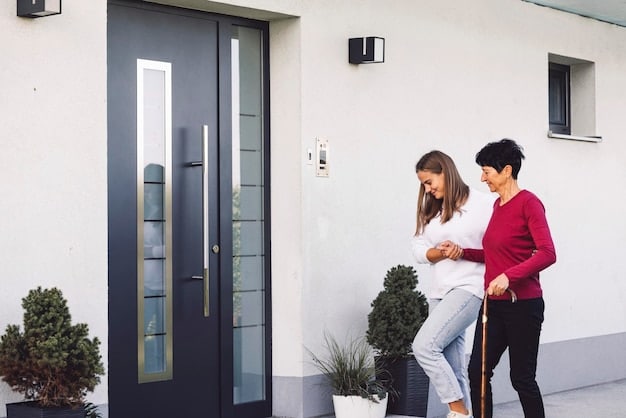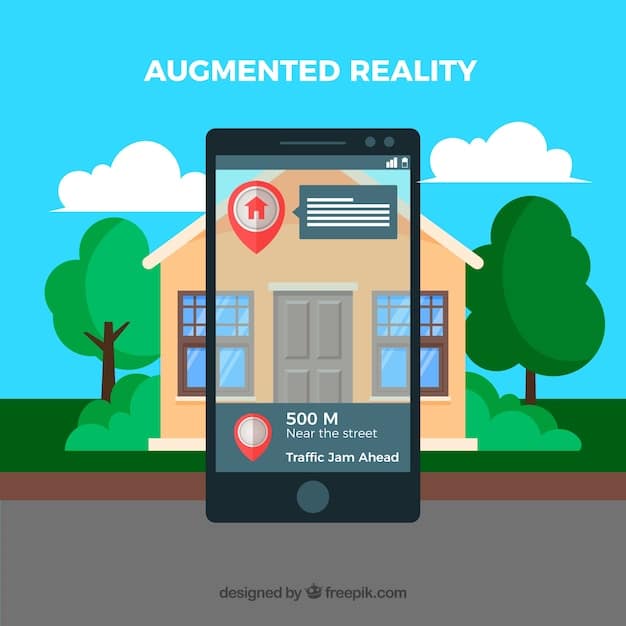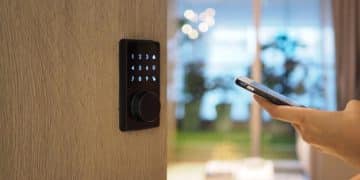Smart Home Security: Automate with Geofencing

Geofencing enhances smart home security by creating virtual boundaries that trigger automated actions, such as arming alarms and locking doors, when residents leave or enter the designated area, providing a seamless and efficient security system management.
Enhance your home’s security without lifting a finger! Discover how smart home security: how to use geofencing to automate your home’s security system can provide peace of mind through automated actions triggered by your location.
Understanding Geofencing and Smart Home Security
Geofencing is a location-based service that defines a virtual perimeter around a real-world geographic area. When integrated with smart home security, it allows for automated actions based on whether a device (typically a smartphone) enters or exits this defined zone.
This technology provides a convenient and proactive approach to home security, reducing the need for manual arming and disarming of systems.
How Geofencing Works
Geofencing operates by utilizing GPS, Wi-Fi, or cellular data to track the location of a mobile device. When the device crosses the virtual boundary, the system triggers pre-set actions.
These actions can include arming or disarming security systems, locking or unlocking doors, turning lights on or off, and even adjusting the thermostat.
- Location Tracking: Uses GPS, Wi-Fi, or cellular data.
- Virtual Boundaries: Defines a specific geographic area.
- Automated Actions: Triggers pre-set instructions when a device enters or exits the geofence.
In essence, geofencing transforms your smartphone into a smart key, automatically managing your home’s security based on your proximity.
Benefits of Using Geofencing for Home Security
Integrating geofencing into your home security setup offers several advantages, making your system more efficient and user-friendly. The automation provided ensures consistent security without requiring constant manual input.
From enhanced convenience to improved energy efficiency, geofencing brings a new level of smartness to your home’s safety net.

Enhanced Convenience
One of the primary benefits is the convenience it offers. You no longer need to remember to arm your security system when leaving or disarm it upon arrival. Geofencing automates this process, ensuring your home is always secured according to your location.
This is particularly useful for busy individuals or families who may often forget to manually manage their security systems.
Improved Security
By automatically arming your security system when you leave, geofencing reduces the risk of forgetting to secure your home. It also enhances security by ensuring that your home is always protected, even when you’re not thinking about it.
Additionally, geofencing can be integrated with other smart home devices to create a comprehensive security ecosystem.
- Automatic Arming/Disarming: No manual input required.
- Consistent Security: Reduces the risk of forgetting to secure your home.
- Integration with Other Devices: Enhances overall security ecosystem.
The seamless integration of geofencing with your smart home devices provides a robust and reliable security solution.
Setting Up Geofencing with Your Smart Home System
Setting up geofencing involves a few key steps, including choosing compatible devices, defining your geofence area, and configuring the automated actions. Most smart home security systems offer user-friendly interfaces to simplify this process.
With a little initial setup, you can create a highly customized and automated security experience tailored to your lifestyle.
Choosing Compatible Devices
Ensure that your smart home security system and devices are compatible with geofencing technology. Most modern systems support this feature, but it’s essential to check the specifications before setting up.
Popular compatible devices include smart locks, security cameras, alarm systems, and smart lighting.
Defining Your Geofence Area
Use the app provided by your smart home system to define the geographic area that will trigger the automated actions. This area should typically encompass your home and surrounding property.
Consider the size of the geofence carefully to avoid false triggers. A smaller radius may be more precise, while a larger radius may be more reliable.
- Check Compatibility: Ensure devices support geofencing.
- Use the App: Define the geographic area via the smart home app.
- Consider Radius Size: Adjust for precision and reliability.
Properly defining your geofence area is crucial for the smooth and accurate operation of your automated security system.

Customizing Automated Actions with Geofencing
The real power of geofencing lies in its ability to trigger a wide range of automated actions. Tailoring these actions to your specific needs and preferences can significantly enhance your home security and convenience.
Whether it’s adjusting the thermostat or activating security cameras, the possibilities are vast.
Arming and Disarming Security Systems
The most common use of geofencing is to automatically arm your security system when you leave your home and disarm it upon your return. This ensures that your home is always protected without manual intervention.
Many systems also allow you to set a delay to prevent accidental alarms when you arrive home.
Locking and Unlocking Doors
Integrating geofencing with smart locks allows you to automatically lock your doors when you leave and unlock them as you approach. This can be particularly useful for those with mobility issues or when carrying groceries.
For added security, you can require a PIN code or biometric authentication when unlocking the door.
- Security System Automation: Arm and disarm automatically.
- Smart Lock Integration: Lock and unlock doors based on location.
- Customizable Delays: Prevent accidental alarms.
By carefully customizing these automated actions, you can create a seamless and highly effective home security system.
Troubleshooting Common Geofencing Issues
While geofencing is generally reliable, occasional issues can arise. These may include false triggers, delayed actions, or connectivity problems. Understanding how to troubleshoot these issues can ensure the continued smooth operation of your system.
Addressing these common issues promptly keeps your system running efficiently.
False Triggers
False triggers can occur if your GPS signal is weak or if your geofence radius is too small. To resolve this, try increasing the size of your geofence or ensuring that your device has a strong GPS signal.
You can also adjust the sensitivity settings in your smart home app.
Delayed Actions
Delayed actions may be caused by connectivity issues or delays in your smart home system. Check your internet connection and ensure that all devices are properly connected to your network.
Restarting your smart home hub or individual devices can also help resolve this issue.
- Increase Geofence Radius: Minimize false triggers.
- Check Connectivity: Ensure a stable internet connection.
- Restart Devices: Reboot hub and connected devices.
By addressing these common issues, you can minimize disruptions and ensure that your geofencing system operates reliably.
Privacy and Security Considerations with Geofencing
While geofencing offers numerous benefits, it’s important to consider the privacy and security implications. Sharing your location data raises concerns about potential tracking and misuse of information.
Being aware of these considerations and taking appropriate precautions can help protect your privacy.
Data Privacy
Understand how your smart home security system collects, stores, and uses your location data. Review the privacy policies of the manufacturers and service providers involved.
Opt for systems that offer robust data encryption and anonymization features.
Security Measures
Secure your smart home network with strong passwords and two-factor authentication. Keep your devices and apps updated with the latest security patches.
Be cautious about granting location access to third-party apps and services.
- Review Privacy Policies: Understand data usage practices.
- Secure Your Network: Use strong passwords and two-factor authentication.
- Update Devices: Keep software and firmware up to date.
By being proactive about your privacy and security, you can enjoy the benefits of geofencing while minimizing potential risks.
| Key Point | Brief Description |
|---|---|
| 📍Geofencing Basics | Virtual boundary that triggers actions when crossed. |
| 🔒Automated Security | Automatically arms/disarms security based on location. |
| 📱Device Setup | Requires compatible devices and precise geofence definition. |
| 🛡️Privacy | Consider data privacy and secure your smart home network. |
Frequently Asked Questions
▼
The range can vary, typically from a few meters to several kilometers, depending on the system and its configuration. Smaller ranges offer more precision, but may lead to false triggers.
▼
Yes, as it requires constant location tracking. However, modern systems are optimized to minimize battery usage. Adjust settings to balance accuracy and battery life.
▼
Geofencing may not function correctly. Some systems have offline capabilities, but it’s best to ensure a stable internet connection for optimal performance.
▼
Like any technology, it can be vulnerable. Securing your smart home network and keeping devices updated are crucial for preventing unauthorized access and potential attacks.
▼
Yes, besides security, it can be used for lighting, thermostats, and other smart devices. Automating these devices based on your location can improve convenience and energy efficiency.
Conclusion
Integrating geofencing into your smart home security system offers a powerful way to automate and enhance your home’s safety. By understanding its benefits, setup process, and potential issues, you can create a seamless and reliable security experience.





